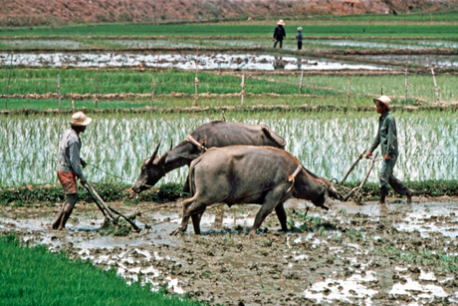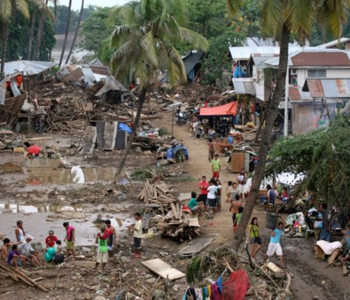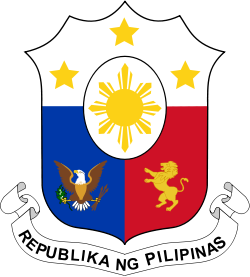Philippines' Second National Communication
Project Overview
The creation of a National Communication offers countries the opportunity to contribute with technically sound studies and information that can be used for designing mitigation and adaptation measures, and project proposals that can and will help increase their resilience to the impacts of climate change. Activities generally include: V&A assessments, Greenhouse Gas Inventory preparation, Mitigation Analysis or Education, and awareness raising activities. The ultimate goal is the integration of climate change considerations into relevant social, economic and environmental policies and actions.
As an archipelagic country with a tropical climate and a total coastline of over 36,000 kilometers, the Philippines is particularly susceptible to ocean based extreme weather events. It experiences an average of 20 typhoons per year. Flooding and landslides are significant risks in the country. In the 2009 Global Assessment Report on Disaster Risk Reduction, the Philippines was ranked eighth in the world with respect to the absolute number of people exposed to floods per year. The same report ranked the Philippines tenth on the Mortality Risk Index for landslides. The Philippines is also vulnerable to earthquakes—experiencing an average of 887 each year —and volcanic eruptions—with 20 of 220 volcanos within the archipelago being active. Due to these factors, the Philippines is considered to be one of the most disaster prone countries in the world.
To view progress on the Philippines' SNC click here.
Project Details
The Philippines is an archipelagic country comprised of more than 7,100 islands that spans an area of roughly 300,000 square kilometers (CIA, 2011). The country lies between 5o to 20o north of the equator. With a population of over 101 million people (CIA, 2011), the Philippines ranks 97 of 169 in the 2010 Human Development Index (UNDP, 2010), placing it in the top half of countries that have achieve a medium level of human development. The country’s economy is dominated by the services sector, which contributes over half of economic output, followed by industry (30 per cent) and agriculture (less than 20 per cent) (USDS, 2010). The country’s topography is characterized by large mountainous terrain with narrow coastal plains and interior valleys and plains. The Philippines has a humid equatorial climate marked by high temperatures and heavy annual rainfall. It is located within the region of ascending air and widespread equatorial cloudiness. Annual rainfall measures as much as 5,000 millimeters in the mountainous parts of the country, but less than 1,000 millimeters in some of the sheltered valleys. The mean annual temperature is about 27oC. The hottest months are April, May and June while the coldest months are December, January and February. In general, the highest temperatures are observed in valleys and plains.
Adaptation Needs and Priorities:
As an archipelagic country with a tropical climate and a total coastline of over 36,000 kilometers (CIA, 2011), the Philippines is particularly susceptible to ocean based extreme weather events. It experiences an average of 20 typhoons per year (World Bank and NDCC, n.d). It also ranks second behind Japan in terms of the absolute number of people exposed to tropical cyclones each year and second behind Bangladesh in terms of its Mortality Risk Index (Peduzzi and Deichmann, 2009).
Flooding and landslides are also significant risks in the country. In the 2009 Global Assessment Report on Disaster Risk Reduction, the Philippines was ranked eighth in the world with respect to the absolute number of people exposed to floods per year (Peduzzi and Deichmann, 2009). The same report ranked the Philippines tenth on the Mortality Risk Index for landslides. The Philippines is also vulnerable to earthquakes—experiencing an average of 887 each year —and volcanic eruptions—with 20 of 220 volcanos within the archipelago being active (World Bank and NDCCRP, n.d). Due to these factors, the Philippines is considered to be one of the most disaster prone countries in the world (Vos et al., 2010). Looking to the future, the Philippines is expected to experience an average temperature increase of between 1.7 and 3.0oC by 2050, with the highest increases projected to occur in the primary agriculture growing regions (OPP, 2010: 9). Rainfall patterns are projected to vary, with some regions seeing up to 16 per cent increases, while others experiencing a drying effect. Sea level rise is projected to result in a land loss of over 129,000 hectares (OPP, 2010: 10).
Given the Philippines current exposure to natural disasters and the continuing importance of agriculture to its national economy, these changes could have significant negative impacts on its population and economic development. Through its first National Communication to the United Nations Framework Convention on Climate Change (UNFCCC) released in May 2000, the Philippines expressed the importance of adaptation to its future development, highlighting in particular the risks posed by extreme climatic events, sea level rise and degradation of marine ecosystems (GEF and UNDP, 2000). The country has taken steps to undertake vulnerability assessments in many areas, particularly agriculture, to determine the potential impacts of changes in climate and weather patterns. It has identified the following sectors as priority areas for adaptation, as well as some proposed adaptation measures (GEF and UNDP, 2000; OPP, 2010):
- Agriculture – priorities include: changes to agricultural management practices; better water management; cropping pattern adjustment to take advantage of growing seasons in relation to rain patterns; advanced weather prediction information that is passed down to local farmers; improved access to agricultural data on diversified farming irrigation strategies; and improved post-harvest handling practices.
- Freshwater resources – priorities include: comprehensive watershed management; water allocation procedures; establishment of irrigation efficiency; recycling/reuse of water; introduction of low water use crops and efficient farming practices; improvement of monitoring and forecasting systems for floods and droughts; water pricing policies and structures; and raising awareness of climate change.
- Coastal and marine management (including fisheries) – priorities include: formulation of guidelines and legislation for the implementation of Integrated Coastal Zone Management; inclusion of wetlands, swamps and marshes as protected ecosystems; limitations on development of land subject to sea-level rise; and long term planning on coastal zone management.
- Disaster risk management
- Forestry
National Level Policies:
The Philippines is establishing a governance framework for mitigating and adapting to the impacts of climate change. While the mandate of the government historically has been more focused on mitigation and energy issues, greater attention is beginning to be given to adaptation as it and public increasing recognize the vulnerability of the country. In 2009, the government passed the national Climate Change Act that enabled creation of a Climate Change Commission responsible for coordinating climate actions and policy through the Office of the President. As well, in 2010, it established the Philippine National Climate Change Framework Strategy to help map out climate policies and prepare international negotiating communications and positions. The Framework Strategy stresses a balance between adaptation and mitigation. Amongst other issues, it emphasizes the need for coastal and marine ecosystem protection for resilience against extreme weather events. As well, it has a focus on equity in adaptation action with respect to protection of the poor, women, children and other vulnerable sectors.
Current Adaptation Action:
The Philippines is currently participating in a moderate number of adaptation projects relative to other East and Southeast Asia developing countries. Current nationally focused projects are addressing a number of adaptation priorities, including research and pilot project implementation in the areas of agriculture and natural resources management; engaging in awareness raising and the development of early warning systems in order to reduce risk to the effects of natural disasters, particularly in flood-affected areas; policy formulation and integration to better address adaptation across a range of sectors; and enhancing resilience within the areas of coastal zones, agriculture, water and natural ecosystems. These projects are being funded by a range of donors including the Asian Development Bank (ADB), the Food and Agriculture Organization (FAO), Special Climate Change Fund (SCCF), United Nations Development Programme (UNDP), United Nations Environment Programme (UNEP), World Bank, World Health Organization (WHO) and the governments of Germany and the United States.
The Philippines is also involved a range of adaptation projects that bring together other Asian countries, as well as a number of projects with a global reach. These multi-country projects are primarily focused on capacity building, vulnerability assessment, and community based adaptation within the following areas: policy formulation, fisheries, coastal zones, agriculture, water, and urban areas. These projects are receiving funding from a wide array of donors, including: the ADB, Asia-Pacific Network for Global Change Research (APN), the European Commission, Global Environment Facility (GEF), the International Development Research Centre (IDRC), the Red Cross/Red Crescent, Southeast Asian Regional Center for Graduate Study and Research in Agriculture (SEARCA), and the governments of Germany, Japan, the Netherlands, Norway, Switzerland, Sweden, the United Kingdom and, in particular, the United States.
Proposed Adaptation Action:
The Philippines plans to be part of two multi-country projects submitted for consideration to the SCCF: “Supporting Sub-National Level Decision Makers to Prioritize Adaptation Initiatives within Development Planning Frameworks,” which will involve countries from around the world; and “Adaptation in the Coral Triangle” involving five Southeast Asian and Pacific island countries.
Assessment:
The Philippines has made significant advancements in addressing climate change both at the policy and project level. It has shown the ability to identify areas of need and develop ways to help meet these needs. Although the country’s policy frameworks are well developed, one of the key challenges faced by the Philippine Climate Change Commission is ensuring the full integration and mainstreaming of adaptation policies and actions from the National Communication to the UNFCCC and the National Framework Strategy. It is the responsibility of the Commission to address inconsistencies and gaps in policy across government. More clarity is also needed on the interaction and interplay of disaster risk reduction and climate change adaptation.
Progress has been made in recent years in balancing mitigation and adaptation actions. The early commitment the country showed to climate change, and the development of a national committee comprising 15 agencies, later replaced by a Commission headed by the President’s Office, no doubt contributed to this progress. Capacity on data and knowledge seems to be improving, however there is a need to improve scientific infrastructure to support research and analysis of climate change exposure, impacts and vulnerabilities to enable targeted policy and planning outcomes.
At the project level, progress is being made in a number of the areas identified as priorities by the government, including risk reduction, coastal zones, fisheries and marine resources, as well as agriculture, water, natural resources management and policy formulation. Gaps appear to persist within the forestry sector, which was also identified as a key area of vulnerability in the country. Moreover, none of the projects identified specifically focuses on addressing the differential gender impacts of climate change, although the Philippine National Climate Change Framework Strategy specifically aims to promote equity in adaptation action, including the protection of women. Future adaptation efforts may transition from the current focus on capacity building and pilot project implementation to more concrete adaptation measures.
Sources:
- Gass, Philip; Hove, Hilary; Parry, Jo-Ellen. (2011) “Review of Current and Planned Adaptation Action: East and Southeast Asia.” Adaptation Partnership / International Institute for Sustainable Development.
- Central Intelligence Agency [CIA] (2011). Philippines. The World Factbook. Retrieved from https://www.cia.gov/library/publications/the-world-factbook/geos/rp.html
- Global Environment Facility [GEF] and the United Nations Development Programme [UNDP] (2000). The Philippines' Initial National Communication on Climate Change. Manila: United Nations Development Programme. Retrieved from http://unfccc.int/essential_background/library/items/3599.php?rec=j&priref=2739#beg
- Office of the President of the Philippines [OPP] (2010). National Framework Strategy on Climate Change 2010-2022. Manila: Climate Change Commission.
- Peduzzi, P and Deichmann, U. (2009). Global Disaster Risk: Patterns, trends and drivers. In United Nations International Strategy for Disaster Reduction Secretariat (UNISDR), 2009 Global Assessment Report on Disaster Risk Reduction. Retrieved fromhttp://www.preventionweb.net/english/hyogo/gar/report/index.php?id=9413.
- Republic of the Philippines (2009). Republic Act No. 9729. Retrieved from http://www.lawphil.net/statutes/repacts/ra2009/ra_9729_2009.html
- United Nations Development Program [UNDP] (2010). Human Development Index 2010. Retrieved from http://hdr.undp.org/en/statistics/
- Vos, F., Rodriguez, J., Below, R. and Guha-Sapir, D. (2010). Annual Disaster Statistical Review 2009: The numbers and trends. Brussels: Centre for Research on the Epidemiology of Disasters. Retrieved fromhttp://reliefweb.int/sites/reliefweb.int/files/resources/7C4BB2DD1D0F292AC125774D004254C5-CRED_Jun2010.pdf
- World Bank and National Disaster Coordinating Council [NDCC] (n.d). Natural Disaster Risk Management in the Philippines: Enhancing poverty alleviation through disaster reduction. Retrieved fromhttp://siteresources.worldbank.org/INTEAPREGTOPENVIRONMENT/Resources/PH_Disaster_Risk_Mgmt.pdf
Key Results and Outputs
- Sustainable development and the integration of climate change concerns into medium- and long-term planning
- Inventories of anthropogenic emissions by sources and removals by sinks of greenhouse gases
- Measures contributing to addressing climate change
- Research and systematic observation
- Climate change impacts, adaptation measures and response strategies
- Education, training and public awareness
Potential Adaptation Measures:
Agriculture and Food Security
- Educational & outreach activities to change management practices to those suited to climate change
- Switch to different cultivars
- Improve and conserve soils
- Enhance irrigation efficiency and/or expand irrigation
- Develop new crops
- Develop and introduce policy measures, including taxes, subsidies, facilitation of free market
- Develop early warning systems and disaster preparedness
Water Resources
- Increase water supply, e.g. by using groundwater, building reservoirs, improving or stabilizing watershed management, desalination
- Decrease water demands, e.g. by increasing efficiency, reducing water losses, water recycling, changing irrigation practices
- Develop and introduce flood and drought monitoring and control system
- Reduce water pollution
- Improve or develop water management
- Alter system operating rules, e.g. pricing policies, legislation
Coastal Zones and Marine Ecosystems
- Develop Integrated Coastal Zone Management
- Develop planning/new investment requirements
- Protect, including building sea walls, and beach nourishment
- Research/monitor the coastal ecosystem
Monitoring and Evaluation
In 1992, countries joined an international treaty, the United Nations Framework Convention on Climate Change, to cooperatively consider what they could do to limit average global temperature increases and the resulting climate change, and to cope with whatever impacts were, by then, inevitable.
Parties to the Convention must submit national reports on implementation of the Convention to the Conference of the Parties (COP). The required contents of national communications and the timetable for their submission are different for Annex I and non-Annex I Parties. This is in accordance with the principle of "common but differentiated responsibilities" enshrined in the Convention.
The core elements of the national communications for both Annex I and non-Annex I Parties are information on emissions and removals of greenhouse gases (GHGs) and details of the activities a Party has undertaken to implement the Convention. National communications usually contain information on national circumstances, vulnerability assessment, financial resources and transfer of technology, and education, training and public awareness.
Since 1994, governments have invested significant time and resources in the preparation, collection and validation of data on GHG emissions, and the COP has made determined efforts to improve the quality and consistency of the data, which are ensured by established guidelines for reporting. Non-Annex I Parties receive financial and technical assistance in preparing their national communications, facilitated by the UNFCCC secretariat.




